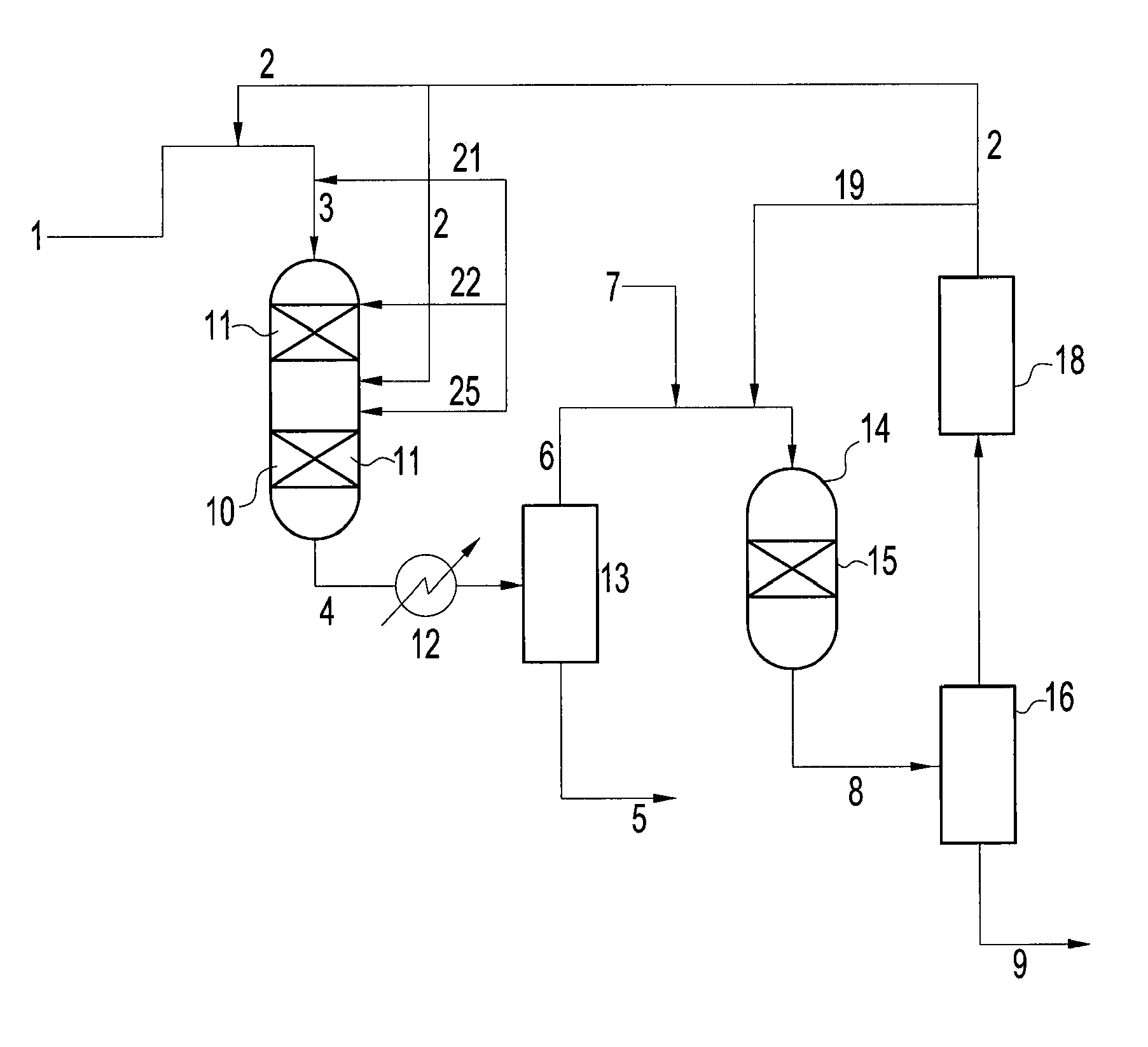Hydrotreatment process
- Summary
- Abstract
- Description
- Claims
- Application Information
AI Technical Summary
Benefits of technology
Problems solved by technology
Method used
Image
Examples
example 1
[0035]Feedstock A (Table 1) is a mixture of 20% by volume of rapeseed oil and 80% by volume vacuum gas oil. The pure vacuum gas oil is denoted Feedstock B. Feedstock A was hydrotreated in a once-through pilot plant using 105 ml of a hydrotreating catalyst (Ni and Mo impregnated on an alumina support). The flow of feedstock A was 105 ml / hr corresponding to a LHSV of 1 hr−1. 100% hydrogen (no recycle) at a pressure of 80 bar was co-fed with the liquid stream at a rate of 73.5 Nl / hr corresponding to a H2 / oil ratio of 700 Nl / l. The temperature of the reactor was maintained at 350° C. Product samples were taken of the liquid effluent. The exiting gas from the reactor was analyzed by gas chromatography.
TABLE 1Properties of feedstock A and B used in the following examplesPropertyFeedstock AFeedstock BS.G.0.91390.9123S (wt %)2.232.88N (wt ppm)494737H (wt %)12.012.2Simulated Distillation (° C.) 5 wt %362.4363.610 wt %376.6376.430 wt %404.0401.250 wt %422.2416.470 wt %442.0430.890 wt %606.245...
example 2
[0040]Feedstock A from Example 1 is processed using the same catalyst and conditions (temperature=350° C., pressure=80 barg, LHSV=1 hr−1, H2 / oil=700 Nl / l) as in Example 1, however H2O was added to the feed before it entered the reactor. Two experiments with 2.1 g H2O / hr and 4.2 g H2O / hr, respectively, were conducted. These water flows correspond to 2.0 vol % and 4.0 vol % of the mass-flow of feedstock A. The results are shown in Table 3, yields are calculated based on the flow of fresh feedstock (excluding H2O).
TABLE 3Properties of products in Example 2Product fromProduct fromFeedstock A.Feedstock A.2.1 g H2O / hr4.2 g H2O / hradded upstreamadded upstreamPropertyreactorreactorLiquid Product AnalysesH (wt %)13.413.4S.G.0.8610.862Yields (wt % Fresh HC Feed)CO0.310.25CO20.630.82H2O3.795.82CH40.140.13C2H60.050.05C3H80.890.85i-C4 + n-C40.050.05H2S + NH32.362.36Liquid Product95.3095.34H2 Consumption (Nl / l)141140Exit Gas Composition (vol %)CO0.370.29CO20.480.60H2O7.0510.39CH40.290.26H288.6785....
PUM
 Login to View More
Login to View More Abstract
Description
Claims
Application Information
 Login to View More
Login to View More - R&D
- Intellectual Property
- Life Sciences
- Materials
- Tech Scout
- Unparalleled Data Quality
- Higher Quality Content
- 60% Fewer Hallucinations
Browse by: Latest US Patents, China's latest patents, Technical Efficacy Thesaurus, Application Domain, Technology Topic, Popular Technical Reports.
© 2025 PatSnap. All rights reserved.Legal|Privacy policy|Modern Slavery Act Transparency Statement|Sitemap|About US| Contact US: help@patsnap.com

